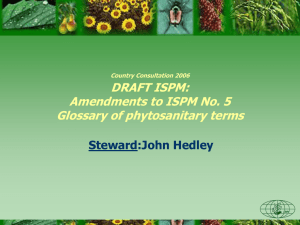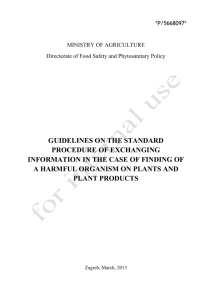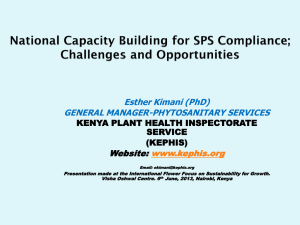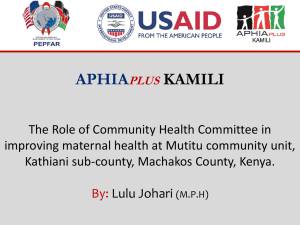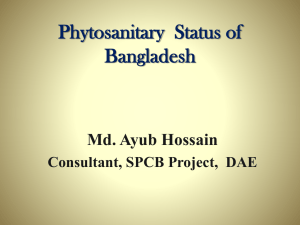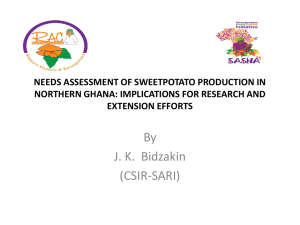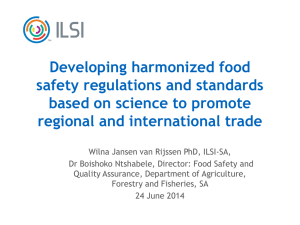Union Fleurs presentation
advertisement
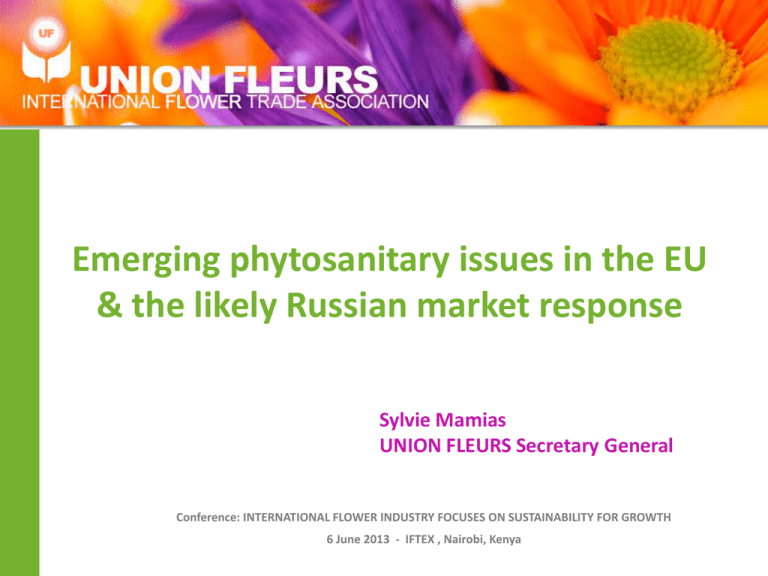
Emerging phytosanitary issues in the EU & the likely Russian market response Sylvie Mamias UNION FLEURS Secretary General Conference: INTERNATIONAL FLOWER INDUSTRY FOCUSES ON SUSTAINABILITY FOR GROWTH 6 June 2013 - IFTEX , Nairobi, Kenya UNION FLEURS: Working for the global flower trade Promote a favorable trading environment and level-playing field conditions through the implementation of proportionate & uniform regulatory measures Facilitate sound, fair and sustainable competitive conditions on major markets Lobbying & advocacy Circulation of information Networking Enhance the visibility of the floricultural sector towards decisionmakers at EU and international levels Union Fleurs – A members-driven organisation - National Members in 20 countries worldwide All major players represented – the Netherlands, Colombia, Kenya, Germany, Italy, Japan, USA etc… associations of flower wholesalers & traders - Individual companies More than 3.000 companies represented within the membership, accounting for 80% of the total value of worldwide exports of floriculture products Union Fleurs Members ITALY SWITZERLAND GERMANY SPAIN BELGIUM AUSTRIA USA KENYA NORWAY MOROCCO DENMARK THE NETHERLANDS TURKEY JAPAN SOUTH AFRICA COLOMBIA SWEDEN ISRAEL Emerging phytosanitary issues in the EU: Does it have anything to do with ‘sustainability for growth’ ? YES! Appropriate ANTICIPATION, PREVENTION and MANAGEMENT of phytosanitary issues at the earliest stage and along the whole supply chain: • help limit the impact on companies of extra costs for rejection at EU borders and of unnecessary administrative burden • enable optimisation of the costs linked to achieving compliancewith the requirements of the EU phytosanitary regulations •ensure a stable access to export markets in the long-term and contribute to sustainable market growth under levelplaying field conditions Phytosanitary issues should therefore be fully integrated in the RISK MANAGEMENT STRATEGY of individual companies and of the global supply chain. The need for responsible and duly diligent operators in tackling phytosanitary issues is vital for the industry but a COLLECTIVE EFFORT is also required to maximise opportunities, actively involving as well the authorities at origin and national organisations. The efficient management of phytosanitary issues at origin is evaluated and rewarded by the EU at COUNTRY-LEVEL, not individual operators. THE EU PLANT HEALTH REGIME Current rules applying to imports of plants & plant products into the EU Upcoming review of the EU regulatory framework EUROPHYT notifications: focus on Kenya performance The EU Plant Health regime OBJECTIVES: • Regulate the trade of plants and plant products within the EU as well as imports from non-EU countries, in accordance with international plant health standards and obligations • In order to prevent the introduction and spread of harmful organisms into the EU territory BASIC PRINCIPLES APPLYING TO IMPORTS FROM NON-EU COUNTRIES: A RISK-BASED APPROACH: Reduced levels of checks are allowed to be applied to safe products from safe origins 100% imported consignments must be checked at the EU borders they must be accompanied by a Phytosanitary certificate issued by the NPPO of the exporting country e.g.: Roses from Kenya : 5% checks Carnations from Kenya: 5% checks Plant health checks must be carried out prior to customs clearance (documentary, identity and plant health inspections) in order to enable plant health inspections services to concentrate their workload on unsafe products from unsafe origins The EU Plant Health regime NEED FOR REFORM & MODERNISATION: • System in place since 1977 without any review • New challenges: With the increase and globalisation of trade in plant products over the last decades and the effects of climate change, the risk of introducing new pests and diseases has increased. • Objective: as far as import of plants from non-EU countries are concerned, the EU should focus its resources on: prevention a reinforced risk-based approach Review of the EU Plant Health regime Current legislation Future legislation Directive 2000/29/EC EU Regulation on Plant Health EU Regulation on Official Controls •Imports from third countries into the EU •Intra-EU trade •Export from the EU to third countries Review of the EU Plant Health regime Main objectives of the review: • Strike a balance between the need to protect the EU territory against the risks of plant pests and the need to minimize potential distortive effects on the trade; • Favor a risk-based approach and risktargeted measures; • Promote prevention strategies to tackle phytosanitary issues at the earliest possible stage and avoid devastating outbreaks; • Implement proportionate and uniform phytosanitary rules across the EU to ensure level-playing field conditions for operators. FUTURE EU Regulation on Plant Health Main elements of the proposed review : General: • Clarified definitions, e.g. plants, plants for planting, competent authority, operator, etc. • Official register of operators • Clarification of operators’ responsibilities Imports into the EU: • Stronger recognition of origin countries with equivalent phytosanitary measures • Introduction of temporary measures concerning risks posed by NEW plants for planting (quarantine) Review of the EU Plant Health regime FUTURE EU Regulation on Official Controls proposal to amend Regulation on Official Controls 882/2004 Food and feed Animal health Animal welfare Specific challenges for floricultural products: highly perishable non-food products need for quick and flexible procedures Plant health Plant reproductive material Residues of veterinary medicines Review of the EU Plant Health regime Main objectives of the review: • Strike a balance between the need to protect the EU territory against the risks of plant pests and the need to minimize potential distortive effects on the trade; • Favor a risk-based approach and risktargeted measures; • Promote prevention strategies to tackle phytosanitary issues at the earliest possible stage and avoid devastating outbreaks; • Implement proportionate and uniform phytosanitary rules across the EU to ensure level-playing field conditions for operators. FUTURE EU Regulation on Official Controls Main elements of the upcoming proposal: • • • • • • Transparency in the Official Control results Cost - based mandatory fees and charges Border Control Posts (BCPs) will replace previous points of entry Right of operators for a supplementary opinion: document review, second analysis/test A Common Health Entry Document (CHED) – fully electronic Description of specific actions to be taken by authorities in case of suspicion and in case of noncompliant consignments Review of the EU Plant Health regime TIMING: May 2013 : Publication of the proposals The proposals will soon be submitted to the European Parliament and the Council for the EU for discussion and adoption (could be a lengthy process) By 2018: Implementation of the reviewed EU Plant Health regime (timing is approximate) EUROPHYT notifications EUROPHYT: European Network of Plant Health Information Systems EUROPHYT facilitates exchange of official information between plant health services of EU Member States (including Switzerland), the European Food Safety Authority (EFSA) and the European Commission EUROPHYT database provides an overview of reported interceptions for plants or plant products that do not comply with EU legislation EUROPHYT provides an essential support for the implementation of preventative measures by ensuring that the data on risks to plant health from trade in plants and plant products is up-to-date and accurate. EUROPHYT notifications Notifications of interceptions of plants/plants products in 2011 - 2012 60 55 54 2011: 410 interceptions 50 47 45 40 37 35 35 33 29 30 30 31 25 28 22 21 15 20 26 20 24 25 27 24 20 14 24 24 16 19 21 2012: 445 interceptions 10 Jan Feb Mar Apr May Jun 2011 (410 interceptions) Jul Aug Sep 2012 (445 interceptions) Oct Nov Dec EUROPHYT notifications Type of commodities involved in EUROPHYT notifications Others 4 Plant products: Others 2 Other living plants: Others 2 Intended for planting: aquatic plants 6 Intended for planting: ! Others 7 14 4 14 Intended for planting: seeds 2013 Other living plants: leaves 16 15 13 24 Intended for planting: cuttings 17 2 Intended for planting: already planted 4 Intended for planting: not yet planted 2011 44 3 Intended for planting: bonsai 2012 18 29 30 58 Other living plants: cut flowers and branches with foliage 0 50 101 74 218 100 150 Number of interceptions 200 236 250 FOCUS ON KENYA PERFORMANCE FOCUS ON KENYA PERFORMANCE FOCUS ON KENYA PERFORMANCE RUSSIA RUSSIA • Huge market growth in terms of cut flowers and pot plants imports over the last 10 years • Russia has joined the WTO in 2012 but remains a difficult trade partner • Should be bound by international regulations, including in the SPS area, but actually uses them as its advantage • Since March 2013, Russia is threatening to introduce an import ban against EU pot plants due to phytosanitary issues – now postponed 3 times – as long as it does not obtain access to the EU market for its Siberian pines (newly promoted ‘negative retroactivity concept’) • Very difficult to plan on stable market access conditions in the long – term. Political games and power play, not just with the EU. Thank you for your attention! info@unionfleurs.org www.unionfleurs.org Visit: www.unionfleurs.org

